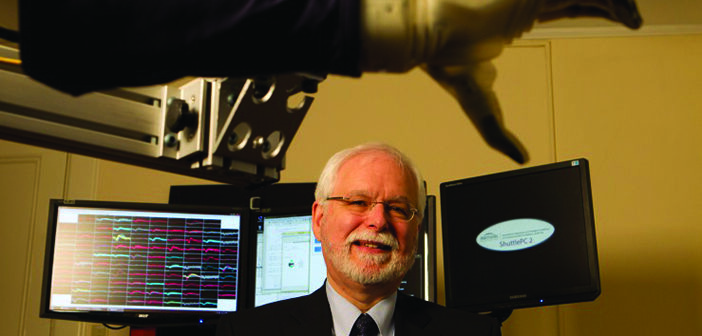Researchers find the brain-computer interface system has low rates of associated adverse events.
More than two decades ago, a team of Brown University researchers set out with an ambitious goal to provide people with paralysis a revolutionary neurotechnology capable of turning thoughts about movement into actual action, using a tiny device that would one day be implanted in the surface of the brain.
Their work led to an ongoing, multi-institution effort to create the BrainGate brain-computer interface, designed to allow clinical trial participants with paralysis to control assistive devices like computers or robotic limbs just by thinking about the action they want to initiate.
Now, after decades of advancements, researchers are getting their best glimpse yet at the safety profile for this promising technology and what it means for long-term use by people affected by neurologic disease or paralysis.
The team’s study, published in Neurology, analyzes more than 17 years of safety data on clinical trials testing the BrainGate technology. The study found a low rate of adverse events associated with the implanted brain-computer interfaces (BCIs) and concluded that the technology should continue to be evaluated for its potential to help people with paralysis regain lost neurologic function.
“In the largest ongoing trial of intracortical brain-computer interfaces, the interim safety profile reported today supports the possibility that these systems may become restorative neurotechnologies for people with paralysis,” says Leigh R. Hochberg ’90, PhD, a professor of engineering and of brain science at Brown and the director of the BrainGate academic consortium that is leading the development and testing of the technology.
BrainGate grew out of fundamental research happening in the late 1990s and early 2000s in the lab of John P. Donoghue PhD’79, the Henry Merritt Wriston Professor of Neuroscience and a professor of engineering at Brown. The new study is an important step for the BrainGate consortium and other BCI research as the current clinical trial enters its 14th year.
“Intracortical brain-computer interfaces have so much promise for restoring communication and mobility,” says Hochberg, who also directs the VA Rehabilitation Research and Development Center for Neurorestoration and Neurotechnology in Providence. “Translating these advances in neural engineering to patient care will depend largely on whether the devices are accompanied by an acceptably low degree of risk.”
The BrainGate device is a type of BCI that is implanted in a part of the brain that controls limb movement. The microelectrode array—called a “Utah” array—is smaller than a contact lens and is placed into the surface of the motor cortex. It works by detecting neural signals associated with intended movements, sending them out to a small nearby computer that then uses algorithms to translate the signals into movement commands.
The ultimate goal of BrainGate is to restore communication, mobility, and independence for people with tetraplegia. Previous studies by BrainGate researchers have shown that the BCI can enable people to move robotic arms or even move their own paralyzed arm and hand.




